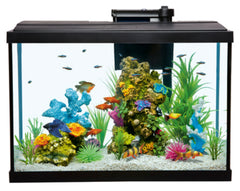My First Aquarium. A Beginner’s Guide.
Your First Aquarium.

Fishkeeping is a wonderful hobby as the sight of beautiful fishes swimming slowly amongst aquatic plants is both relaxing and helps bring nature into our homes. However it can be a daunting task for a newcomer to setup their first aquarium as there seems to be so much to do to!
Here we'll touch on some of the basic fishkeeping knowledge one will need to embark on this rewarding hobby.
1. Considerations.
- Choose the biggest aquarium that fits your space and budget. The fishes will enjoy the additional swimming space. It is also easier to keep water parameters stable in bigger tanks.
- Research on the different types of fishes before buying to ensure compatibility with other tankmates and to understand their requirements.
- Rough calculation on the number of fishes you can keep in your tank:
- 1cm of fish : 1L water
- Goldfish, Koi, Monster Fishes. 1cm of fish : 2L water
2. Identify a suitable location.
- The aquarium should be located at a well-ventilated location out of direct sunlight where temperature is relatively constant.
- Check that the surface is level. It is recommended to use Cabinets that are designed to support the weight of your aquarium.
3. Getting the tank ready.
- Check the tank for leaks by filling up with water.
- Test that the filters and lights are in good working condition.
- Wipe the tank clean with a clean damp cloth. DO NOT use detergent or cleaning agent.
- Place the tank in final position.
4. Preparing the aquarium decorations.
Aquarium decorations are a great way to introduce hiding space for your fishes and also create visual interest. You can consider natural decors (wood, stones, and aquatic plants), substrates (gravels, soil or sand), and/or artificial ornaments.
- Rinse and wash the gravels and ornaments thoroughly to remove any sediments and dirt. DO NOT wash aquarium soil.
- Pour the substrate into the tank. Create a gentle slope from the front (lower) to the back (higher), this helps to make the tank looks bigger.
- Put in the decors/ornaments.
5. Adding water to the Aquarium.
- Do not pour water directly on the substrate as the water will disturb the substrate and stir up sediments which causes the water to be cloudy. Put a plastic sheet on the substrate and gently pour water on the sheet.
- Add anti-chlorine solution according to recommended dosage to your tap-water to remove harmful chlorine and chloramine.
- Turn on the filter and allow the water to run for 15 minutes before adding Beneficial Bacteria. The beneficial bacteria will help to break down harmful toxins produced by the fishes.
6. Allow Tank to mature (establish Nitrogen Cycle).
You might have heard about "cycling" a tank or letting a tank "mature". Actually what these means is to allow a colony of beneficial bacterias to establish within your tank and filter, and they will help breakdown toxic Ammonia and Nitrite. Most fish deaths occur in the first 2 weeks due to Ammonia and/or Nitrite poisoning, thus it is not recommended to skip this step. Read more Aquarium Nitrogen Cycle.7. Testing your water.
Water tests are an integral part of fishkeeping as it helps to let us know we are doing things right. Test kits allow hobbyists to test for different parameters, e.g. Ammonia, Nitrite, Nitrate, pH, etc.- We use aquarium test kits that helps measure Ammonia and Nitrite levels to check if our tank is "cycled" or "matured".
- Test your water for Ammonia and Nitrite, and the result we are looking for is zero level of Ammonia and Nitrite. Now your tank is ready for their first inhabitants!
8. Keeping your tank clean.
- It is recommended to do a 20-40% water change at least once a week. A Siphon and Gravel Cleaner will allow you to siphon out any detritus or fish waste from the bottom of the tank during water change.
- Use an algae cleaner to remove any green dust algae from the glass tank, for the best result, do this step before the water change.
- Check the filter wool to ensure it is not clogged, replace it if it is clogged.
- Add in anti-chlorine solution before refilling your tank with tap water.
Important: This is a general guide for beginners, and hobbyists are advised to factor in their tank conditions (e.g., types of fishes, number of fishes, feeding frequency, etc.) when following the advice. In no event shall we be liable for any claims, penalties, loss, damage or expenses, howsoever arising, out of or in connection with your use of this guide, including, without limitation, direct or indirect loss, consequential loss or damage. Nothing in these Terms and Conditions shall exclude or limit our liability for death or personal injury caused by negligence or for any liability which cannot be excluded or limited under applicable law.
